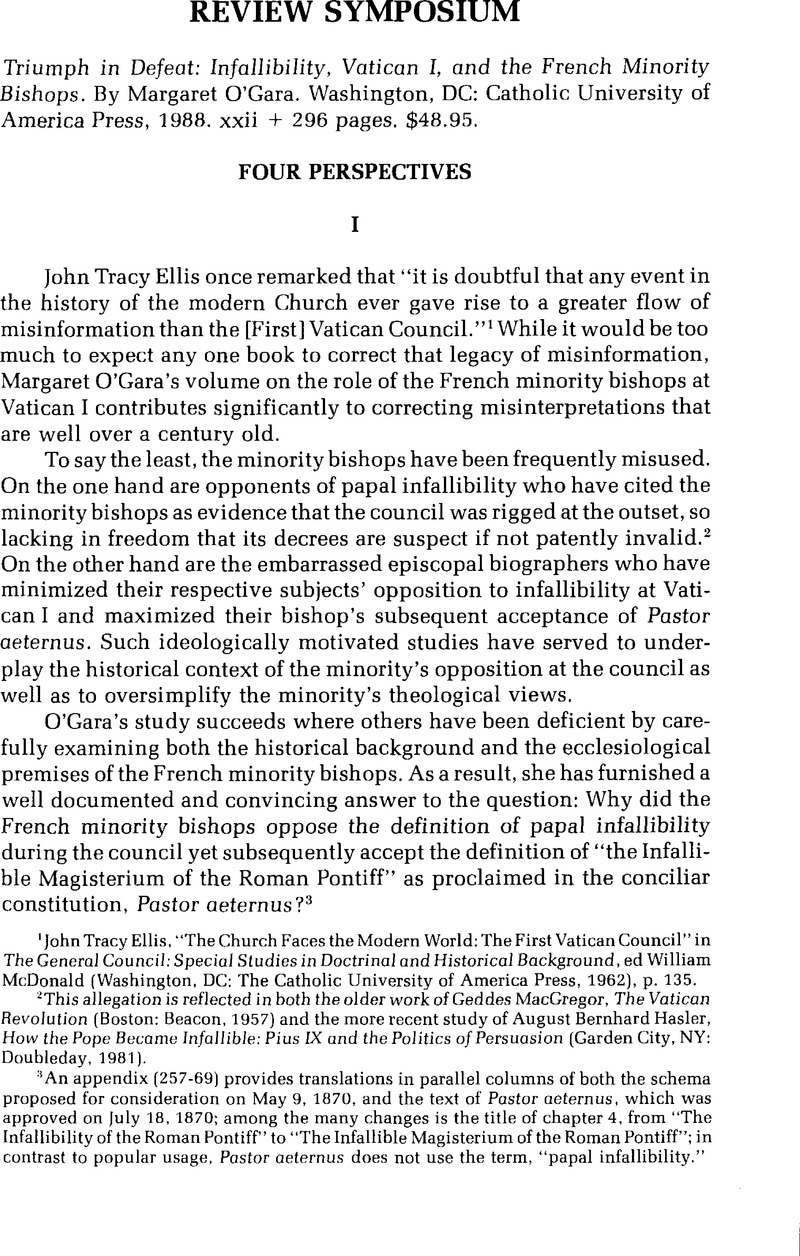No CrossRef data available.
Published online by Cambridge University Press: 09 September 2014

1 Ellis, John Tracy, “The Church Faces the Modern World: The First Vatican Council” in The General Council: Special Studies in Doctrinal and Historical Background, ed McDonald, William (Washington, DC: The Catholic University of America Press, 1962), p. 135.Google Scholar
2 This allegation is reflected in both the older work of MacGregor, Geddes, The Vatican Revolution (Boston: Beacon, 1957)Google Scholar and the more recent study of August Hasler, Bernhard, How the Pope Became Infallible: Pius IX and the Politics of Persuasion (Garden City, NY: Doubleday, 1981).Google Scholar
3 An appendix (257-69) provides translations in parallel columns of both the schema proposed for consideration on May 9, 1870, and the text of Pastor aeternus, which was approved on July 18, 1870; among the many changes is the title of chapter 4, from “The Infallibility of the Roman Pontiff” to “The Infallible Magisterium of the Roman Pontiff”; in contrast to popular usage, Pastor aeternus does not use the term, “papal infallibility.”
4 An estimate of the minority's strength was given by Lord Acton in a letter from Rome to Lord Granville on February 17, 1870: “The real difficulty for observers is to make out the character and face of the opposition. About 130 have signed an address demanding that the dogmatic question [of papal infallibility] be swamped, and at least 100 more have refused to sign an address of the contrary purport. They do not form a compact group. Some are acting on this side because they think the definition dangerous; some, because they think it difficult; and some because they think it utterly inadmissible” (Lord Acton, The Decisive Decade, 1864-1874, Essays and Documents, by McElrath, Damian in collaboration with Holland, James and White, Ward, Katzman, Sue [Louvain: Publications Universitaires, 1970], p. 84Google Scholar). The final vote on Pastor aeternus on July 18, 1870 was 533 placet (in favor) and 2 non placet (against).
5 Newman, to Mrs.Froude, (January 2, 1871), The Letters and Diaries of John Henry Newman 25:262.Google Scholar
6 A translation of Gasser's speech on July 11, 1870, is given in The Gift of Infallibility: The Official Relatio of Bishop Vincent Gasser at Vatican Council I by O'Connor, James (Boston: St. Paul Editions, 1986).Google Scholar
7 The two bishops casting negative votes were Riccio, Luigi of Cajazzo and Fitzgerald, Edward of Little Rock, Arkansas. “What prompted Fitzgerald to vote ‘no’ at the public session has never been satisfactorily explained” (Hennesey, James, The First Council of the Vatican: The American Experience [New York: Herder and Herder, 1963], p. 281).Google Scholar
8 O'Gara's observation that “the Old Catholic schism affected a large number of believers” (202, n. 23) could be nuanced by the information given by Conzemius, Victor, “Catholicism: Old and Roman,” Journal of Ecumenical Studies 4 (1967), 426–45Google Scholar, and “Old Catholicism: A Forgotten Lesson of Catholic Reform,” Louvain Studies 4 (1972–1973). 320–37.Google Scholar